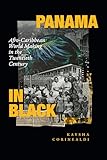Panama in Black : Afro-Caribbean world making in the twentieth century / Kaysha Corinealdi.
Material type: TextLanguage: English Publication details: Durham : Duke University Press, 2022Description: xiii, 266 pages : illustrations ; 24 cmISBN:
TextLanguage: English Publication details: Durham : Duke University Press, 2022Description: xiii, 266 pages : illustrations ; 24 cmISBN: - 9781478018513
- 1478018518
- 305.896/07287
- 114 F 1577 C798p 2022
| Item type | Current library | Home library | Collection | Shelving location | Call number | Copy number | Status | Date due | Barcode |
|---|---|---|---|---|---|---|---|---|---|
 Libro
Libro
|
Biblioteca Juan Bosch | Biblioteca Juan Bosch | Recursos Regionales | Recursos Regionales (2do. Piso) | 114 F 1577 C798p 2022 (Browse shelf(Opens below)) | 1 | Available | 00000178383 |
Introduction: Legacies of exclusion and Afro-Caribbean diasporic worldmaking
Panama as diaspora : documenting Afro-Caribbean Panamanian histories, 1928-1936
Activist formations : fighting for citizenship rights and forging Afro-diasporic alliances, 1940-1950
Todo por la Patria : diplomacy, anticommunism, and the rhetoric of assimilation, 1950-1954
To be Panamanian : the canal zone, nationalist sacrifices, and the price of citizenship, 1954-1961
Panama in New York : Las servidoras and engendering an educated Black diaspora, 1953-1970
Conclusion: Afro-Caribbean Panamanians and the future of diasporic world making
In Panama in Black, Kaysha Corinealdi traces the multigenerational activism of Afro-Caribbean Panamanians as they forged diasporic communities in Panama and the United States throughout the twentieth century. Drawing on a rich array of sources including speeches, yearbooks, photographs, government reports, radio broadcasts, newspaper editorials, and oral histories, Corinealdi presents the Panamanian isthmus as a crucial site in the making of an Afro-diasporic world that linked cities and towns like Colón, Kingston, Panamá, Brooklyn, Bridgetown, and La Boca. In Panama, Afro-Caribbean Panamanians created a diasporic world view of the Caribbean that privileged the potential of Black innovation. Corinealdi maps this innovation by examining the longest running Black newspaper in Central America, the rise of civic associations created to counter policies that stripped Afro-Caribbean Panamanians of citizenship, the creation of scholarship-granting organizations that supported the education of Black students, and the emergence of national conferences and organizations that linked anti-imperialism and Black Liberation. By showing how Afro-Caribbean Panamanians used these methods to navigate anti-Blackness, xenophobia, and white supremacy, Corinealdi offers a new mode of understanding activism, community, and diaspora formation.


There are no comments on this title.